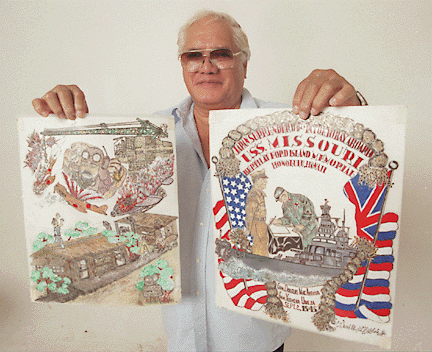


Artist honors hero of
By Harold Morse
Pearl Harbor attack
Star-BulletinPearl Harbor Day hero George Walters -- who used a huge crane to shield the Pacific Fleet flagship, the battleship Pennsylvania, from attacking enemy planes -- had gone virtually unknown until Walter Lord's book "Day of Infamy" came out almost 16 years after the Pearl Harbor attack.
Walters also used the 50-ton crane's boom to point toward attacking planes and alert U.S. gunners that day.
Lord, in his acclaimed book, set the scene for Walters' crane exploits: "The three ships in the main drydock fought under a special handicap. The water had been pumped out, dropping their decks to a point where the high sides of the drydock blocked most of the view. This was noticed right away by George Walters, a civilian yard worker operating a traveling crane that ran on rails along the side of the dock.
"From his perch 50 feet up, Walters saw the first planes dive on Ford Island. Like everybody else, he thought it was a drill and caught on only when he saw the PBYs (Navy amphibious planes) crumble.
"He looked down and realized that the men lolling in the sun on the Pennsylvania . . . were aware of none of this. He yelled but nobody paid attention. He threw a wrench, but that only made them angry. As the attack spread all over the harbor, they finally understood.
"When the Japanese turned their attention to the Pennsylvania, Walters . . . devised a unique defense. He ran his crane back and forth along the ship, hoping to protect it and ward off low-flying planes."
Lord continued: "The crane's movement at least gave them (anti-aircraft gunners) a lead on where a plane might next appear. Then they could set their guns and be ready when it came."
Some witnesses credited Walters with saving the Pennsylvania and helping gunners down eight to 10 attacking planes.
After a 500-pound bomb exploded nearby, damaging the crane and stunning Walters, he nearly fell from the crane. But Walters had moved the crane just in time to avoid a direct hit from the bomb, which left a 17-foot crater.
Two years ago, David Milikaa, who does graphic black-ink drawings, put Walters and his crane in a cartoonlike montage of the Pearl Harbor attack, which Milikaa witnessed as a 6-1/2-year-old boy. The montage also appears on T-shirts.
Milikaa more recently completed a similar piece of artwork depicting the Japanese surrender aboard the USS Missouri to mark the end of World War II, completing it in time for the Jan. 29 opening of the Missouri memorial.
Milikaa, a body-and-fender repairman at Navy Public Works Center at Pearl Harbor, didn't include Walters in his battleship Missouri artwork. He met Walters, now 95, for the first time last week.
"I felt good inside and happy," he said. "I took one of the T-shirts. . . . He tried it on. He liked it. He was so happy. It fit him just right."
Walters, a Denver native, came to Hawaii at age 14 months, first working at Pearl Harbor in 1935. He was a crane operator until 1950. He retired in 1966.
Reliving the Pearl Harbor attack again at his Salt Lake home, Walters recalled how attacking planes hedgehopped their way right over his crane, so low they had to pull up to avoid the boom when he swung it their way.
Looking back, he knows he would have been a dead man had a plane actually hit the boom -- though the thought never occurred to him then. What he did, Walters said, was "just impulse."
He looks back on his close calls, wondering how he survived.
"Why God has protected me, I don't know. But he must have had a reason," he said. "Every piece of glass in that crane was destroyed."